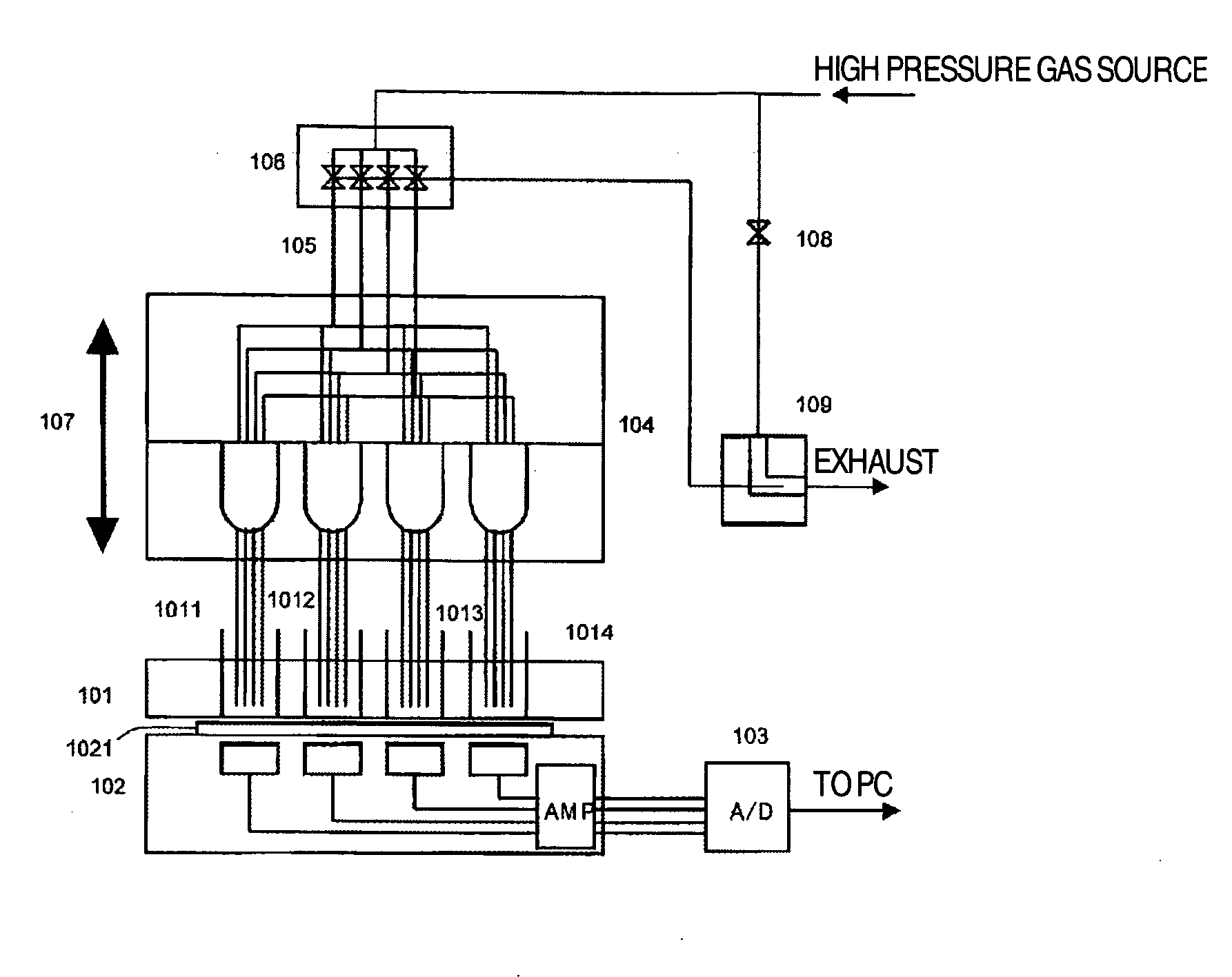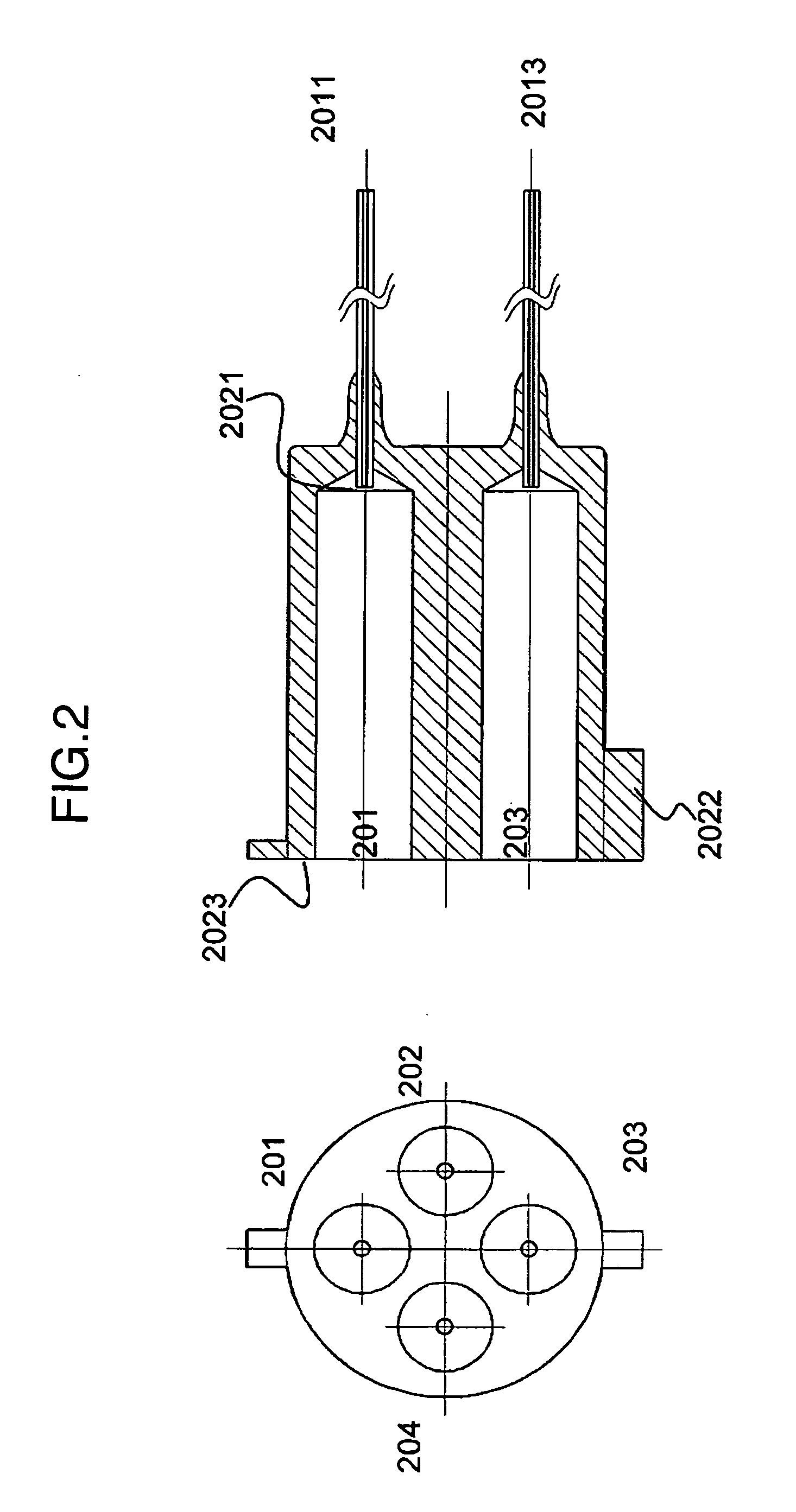Small size gene analysis apparatus
a gene analysis and small-scale technology, applied in chemical methods analysis, laboratory glassware, instruments, etc., can solve the problem of providing air gaps in the capillaries, and achieve the effect of small size, desired dispensing accuracy, and inexpensive arrangemen
- Summary
- Abstract
- Description
- Claims
- Application Information
AI Technical Summary
Benefits of technology
Problems solved by technology
Method used
Image
Examples
embodiment 1
[0036] Now, the present invention will be described referring to Embodiments.
[0037] In the present invention, the target gene sequence to measure is determined by using the principle of the pyrosequencing method described in the Description of Related Art section. First, an example of the configuration of the apparatus for analysis according to the present invention is shown in FIG. 1(a). First, the apparatus has a reaction vessel holder 101. The holder 101 supports four reaction vessels 1011 to 1014 in a single row with a pitch of 9 mm. The present apparatus performs nucleic acid extension using enzymes, and enzymatic reactions, in general, work efficiently when the temperature is higher than room temperature, so that it is more preferable that temperature controlling means (such as a peltier element), by which heating or cooling to a given temperature can be conducted, is connected to the holder. In addition, in this embodiment, four reaction vessels are placed with a pitch of 9 ...
embodiment 2
[0055] Another embodiment related to dispensing reagents using the apparatus described in Embodiment 1 is described. First, when one substrate is dispensed, a lower concentration or a smaller volume of the reagent is preliminarily prepared and dispensed plural times. By using the present apparatus, such dispensing method can be readily realized. This is effective on occasions such that a concentration of the reagent is lowered in order to decrease leaking molecular weight, when the volume of leakage is about 0.6 nL, as described above; or that on continuous sequence analysis, a sequence continuously formed by the same base is observed, and thus the need of the additional reagent arises. In this embodiment, a case wherein dispensing is performed twice is described. FIG. 6 is an illustration of the time sequence of operations of the dispensing head, pressurization, and the vibration stirring motor, when one reagent is divided into two portions to dispense. When a single reagent is div...
embodiment 3
[0058] Another embodiment related to the method of dispensing a plurality of reagents simultaneously using the apparatus described in Embodiment 1 is described.
[0059] In Embodiment 2, four substrates are dispensed one by one, but two, three, or all, i.e., two or more substrates can be optionally dispensed at the same time. It is important that the same dispensing chip that is used for usual sequence analysis can be used in such case as well. For example, in one of the techniques of analyzing polymorphism, in order to evaluate polymorphism at the extension probe side, polymorphism is allowed to be present at the 3′-terminal, wherein complementarity is analyzed. In this case, a mixture solution of four substrates is used as the reagent. Therefore, handling is different from normal reagents for sequence analysis, and a mixture solution of four substrates is particularly prepared for the polymorphism analysis. However, in the present apparatus, after sequence analysis is conducted, the...
PUM
| Property | Measurement | Unit |
|---|---|---|
| volume | aaaaa | aaaaa |
| size | aaaaa | aaaaa |
| pressure | aaaaa | aaaaa |
Abstract
Description
Claims
Application Information
 Login to View More
Login to View More - R&D
- Intellectual Property
- Life Sciences
- Materials
- Tech Scout
- Unparalleled Data Quality
- Higher Quality Content
- 60% Fewer Hallucinations
Browse by: Latest US Patents, China's latest patents, Technical Efficacy Thesaurus, Application Domain, Technology Topic, Popular Technical Reports.
© 2025 PatSnap. All rights reserved.Legal|Privacy policy|Modern Slavery Act Transparency Statement|Sitemap|About US| Contact US: help@patsnap.com



